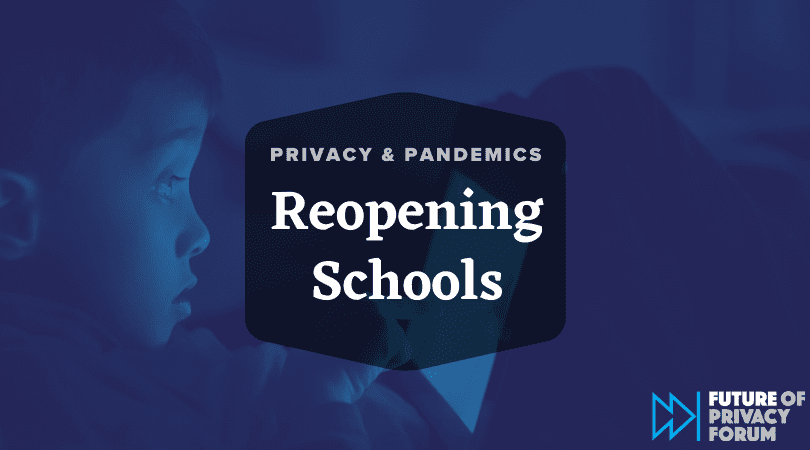The debate over whether educational institutions should offer in-person or remote learning, or a mix of both, is unlikely to slow down anytime soon as COVID-19 cases remain high in many parts of the country and rose 90% among children from early July to early August. Any of these learning options raise significant implications for student privacy and equity, and The Future of Privacy Forum has developed a new issue brief series to highlight the concerns keeping us up at night. Don’t miss our previous issues on the student privacy implications of increased data collection and storage, thermal scans and temperature checks, wearable technologies, and location tracking.
Issue Brief: Online Monitoring & COVID-19
Schools and teachers have always had to track and monitor routine metrics such as attendance and academic progress, but what does this look like in an online learning environment? How should teachers track participation, engagement, and behavior during distance learning? What about monitoring for potential cheating during online test-taking? With the knowledge that online learning already poses a “real risk” of deepening the existing inequities in education, schools and teachers should use student data to better understand whether they have access to a reliable device or Wi-Fi connection, how well they understand the content and their assignments, and if any students require further support. In collecting student data for these metrics, schools and teachers must ensure it is collected in a way that avoids doing more harm than good.
As online learning becomes more common and sophisticated, schools can track more information about students and their online behavior than ever before. While some of this monitoring is required by law, those laws were not designed for an entirely online learning environment, and schools and districts have very little procedural guidance. As a result, school data collection and monitoring practices across the nation following COVID-19-related closures last spring were inconsistent, “raising questions about everything from graduation requirements to school funding formulas,” and basic processes like tracking student attendance became a “complicated mess.”
Schools are struggling with measuring attendance or attentiveness in a remote or online learning environment, and with using monitoring data without sacrificing student privacy. In one state, a student’s time spent logged into a learning management program, video and call interactions, or assignment submissions are being used as proxies for student attendance.
But how much can – and should – a school analyze the amount of time a student spent logged into a school learning management system (LMS) or whether a student has their camera on during virtual video classes? There are important and clear examples where the number of minutes logged in is not an accurate measurement for attendance or participation. What if a student forgets to log in that morning—or forgets to log out? What about English Language Learners who click away from the video conferencing software to help them with translation to understand the lesson better? What if a student with limited Wi-Fi can’t turn on their camera function every day? Should these students be penalized for their perceived lack of participation?
While student data can be and is often used to improve educational outcomes, over-monitoring also poses serious legal, practical, and cultural risks. Students of lower socioeconomic status may only have computer access through school-administered devices, so schools will inherently monitor more of their activity, even when it is not related to school tasks. During the pandemic, when those devices may be students’ only connection to family and friends outside their home, this type of monitoring can be especially invasive.
Ultimately, learning analytics and monitoring software work best when used “not as a stealth spying method,” but instead openly and with transparency to avoid “the creepiness factor.” Schools should be wary of over-interpreting the new data they will undoubtedly be using this fall, while clearly communicating to teachers, parents, and students how students will be monitored and assessed. Clear communication will help build trust and allow families and students to ask questions and share their concerns. By prioritizing equity, transparency, and privacy, schools can resist the impulse to confuse surveillance for care and instead develop effective monitoring policies that allow them to collect and use valuable student data while respecting student privacy as we enter “a whole new world” in American education.
As always, we welcome the opportunity to discuss these issues with you further. Please feel free to contact us here at any time.
FPF Resources:
- FPF and the National Center for Learning Disabilities (NCLD), Student Privacy and Special Education: An Educator’s Guide During and After COVID-19
- Resources List: Student Privacy During the COVID-19 Pandemic (last updated August 13, 2020)
- Beyond the Fear Factor: Parental Support for Technology and Data Use in Schools
- 19 Times Data Analysis Empowered Students and Schools
- The Privacy Expert’s Guide to Artificial Intelligence and Machine Learning
In the News:
- FPF and the National Center for Learning Disabilities (NCLD), Student Privacy and Special Education: An Educator’s Guide During and After COVID-19
- Resources List: Student Privacy During the COVID-19 Pandemic (last updated August 13, 2020)
- Beyond the Fear Factor: Parental Support for Technology and Data Use in Schools
- 19 Times Data Analysis Empowered Students and Schools
- The Privacy Expert’s Guide to Artificial Intelligence and Machine Learning
Additional Resources:
- National Association of State Boards of Education: School Surveillance: The Consequences for Equity and Privacy
- Electronic Frontier Foundation: Proctoring Apps Subject Students to Unnecessary Surveillance (August 20, 2020)
- Surveillance Technology Oversight Project: Schoolyard Surveillance
- ACLU of Northern California: Student Rights During the COVID-19 Pandemic
- Common Sense Media and Boston Consulting Group: Closing the K-12 Digital Divide in the Age of Distance Learning
- Common Sense Media: Parents’ Ultimate Guide to Parental Controls (June 8, 2020)
- National Conference of State Legislatures: Children and the Internet: Laws Relating to Filtering, Blocking and Usage Policies in Schools and Libraries
- American Library Association: Fencing Out Knowledge


